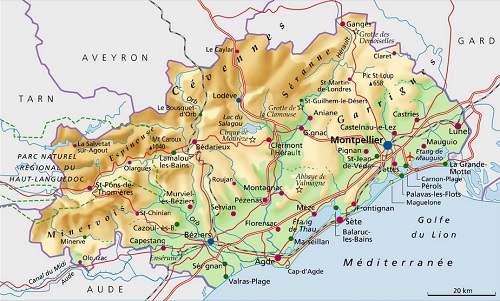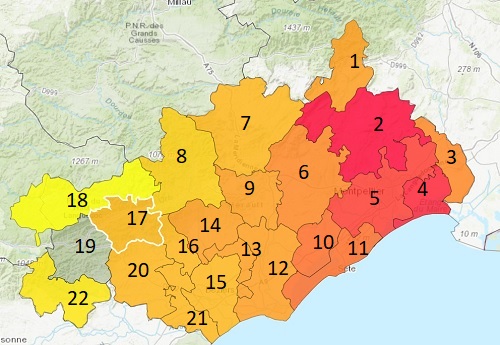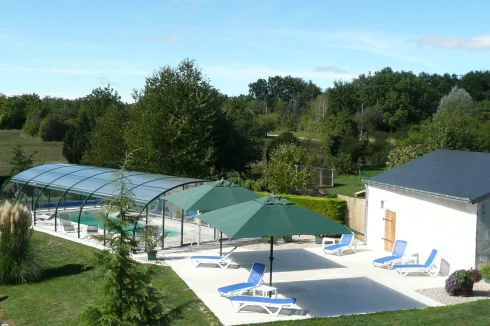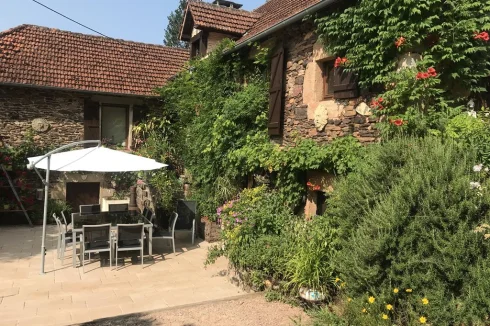House Prices in Herault
Thursday 07 December 2017
In the Mediterranean department of Herault, wherever you live, the mountains are close and the sea is not too far away.
Located in the region of Occitanie, looking out to the Gulf of Lion, the department of Herault has a three-tiered geographic relief, comprising mountains, scrub-land and plains.
In the heights to the rear are the mountain areas, reaching over 1000 metres, the residue of the Massif Central, comprising forest, moorland, the limestone plateau of Larzac, and spectacular gorges. Together they account for one-third of the land area of the department. Most of it is a protected area of outstanding natural beauty.
The intermediate area is characterised by garrigues (scrubland) of the Herault Valley to the East, whilst to the west rolling hills that are planted with vineyards.
At the base, there are the plains, essentially agricultural and urban in nature, which meet a 100 km coastline, mainly a glorious succession of freshwater and saltwater lagoons (Thau, Frontignan, and Mauguio) separated from the sea by a thin dune cord.

Source: Larrouse
Demographics
Since the 1960s the department has witnessed a galloping level of demographic change, with the population doubling from around 550,000 to 1.1 million today, twice the national average.
The growth is the result of an influx of arrivals from other areas of France, drawn to the department by the climate and economic opportunity. Only 71,000 of the inhabitants are foreign nationals, of whom around 3,000 are British. A similar number of British nationals own a second home in the department.
Most of the newcomers have relocated to the coastal areas and to the east of the department, around the youthful and dynamic capital of Montpelier. The metropolitan area of the city shelters 421,000 inhabitants, some 38% of the population of the whole department. Indeed, around three-quarters of the population of the department live within 15 km of the coastal A9 autoroute.
To meet the needs of the rising population and tourists, for many years there has been a substantial new build housing programme of around 10,000 new homes a year, one of the largest in France. Most of the new development has occurred around the Montpelier agglomeration, the coastal urban centres, and the second city of Beziers.
That programme has included many holiday homes, mainly apartments located along the coast, which today account for one-quarter of the 700,000 total housing stock. In the municipal areas of the Pays de l'Orn and Hérault-Méditerranée over 50% of the properties are second homes. In some of the village resorts, holiday homes exceed the number of principal residences, such as Marseillan, Balaruc-les-Bains, Valras-Plages, Portiragnes and the pyramidal 60s resort of La Grande-Motte.
Despite the demand for housing, some 7% (48,000) of the housing stock is vacant, rising to 15% or more in several administrative areas of the department.
The scale of new build housing and commercial development has taken its toll on the authenticity of the coastal area, which is now characterised by a curious blend of modern and traditional, with several tourist resorts that sit cheek by jowl with old fishing ports and stunning wildlife reserves. Whatever you want to do or see, you can find it along the Herault coastline.
Between them the local councils and the coastal protection agency, the Conservatoire du Littoral, have intervened to offer greater protection to the area, designating and buying up huge stretches of land, but the tension between economic development and environmental protection is always being played out. Coastal erosion due to climate change is also becoming a major problem for the authorities.
Inland, whilst most villages and towns have seen some development on the periphery, the pressures have been more modest, and such development that has occurred has contributed towards the retention of commercial and other services. And despite the urban sprawl around Montpelier, the city centre itself is well-managed and attractive, with one of the largest pedestrianised spaces in Europe.
There is an endless, diverse and striking countryside, which the local councils invest large sums each year to protect and develop, with rural leisure activities available in abundance, one of the key benefits of the demography of the department. The scale of wine production (13% of the national total) contributes significantly to the range of social and cultural activities.
House Prices
Not surprisingly, the popularity of the department is reflected in the level of house prices, which average €2,160m2, or €211,000, the highest in the Occitanie region, and the sixth highest in France outside of the Ile-de-France.
Highest prices are to be found in the east of the department, around Montpelier and the Pays de l'Or, and in the municipal area of Grand Pic Saint-Loup, where prices average around €300,000. However, in the hinterland prices fall significantly, with lowest prices to be found in the south and west of the department.
The map below divides the department into communauté de communes, inter-municipal councils that are gradually taking the place of the local commune as the local administrative centre within each department. These councils are in a state of transition, and some have merged or are in the process of merger, so the map is not entirely up-to-date.
The colour coding on the map indicates an average price range, increasing in price from light yellow to red, for each municipal area in the department.
Lowest prices are €78,000 for Montagne du Haut Languedoc (18) to €328,000 for Grand Pic Saint-Loup (2).

The table below shows the average movement in house prices for each municipality above, for the 5-year period 2012-17, as well as the most currently published average house prices for each area.
Overall, in the past 5 years prices in the department have risen by 1.5%, but as can be seen, there are very substantial internal variations.
As usual, the table should only be used for general guidance. These municipal areas are large, some covering a quite disparate area, and prices will vary, depending on the size, location and condition of the property.
| House Prices Herault | |||
| No | Municipality | Average Change 2012/17 | Average Price July 2017 |
| 1 | Cévennes Gangeoises et Suménoises | -11.5% | €180,000 |
| 2 | Grand Pic Saint-Loup | +0.7% | €328,000 |
| 3 | Pays de Lunel | -3.3% | €203,000 |
| 4 | Pays de l'Or | +10.9% | €300,000 |
| 5 | Montpellier Méditerranée Métropole | -5.9% | €285,000 |
| 6 | Vallée de l'hérault | +4.6% | €206,000 |
| 7 | Lodévois et Larzac | +22.5% | €155,000 |
| 8 | Grand Orb en Languedoc | 0.0% | €120,000 |
| 9 | Clermontais | -11.9% | €177,000 |
| 10 | Nord du Bassin de Thau | +9.3% | €238,000 |
| 11 | Bassin de Thau | -1.9% | €223,000 |
| 12 | Hérault-Méditerranée | +0.3% | €172,000 |
| 13 | Pays de Thongue | +0.6% | €166,000 |
| 14 | Avant-Monts du Centre Hérault | -3.6% | €166,000 |
| 15 | Béziers-Méditerranée | -4.8% | €160,000 |
| 16 | Orb et Taurou | -3.5% | €152,000 |
| 17 | Orb et Jaur | +42.9% | €150,000 |
| 18 | Montagne du Haut Languedoc | -22.0% | €78,000 |
| 19 | Pays Saint-Ponais | n/a | n/a |
| 20 | Sud-Hérault | +8.5% | €141,000 |
| 21 | La Domitienne | +2.2% | €165,000 |
| 22 | Le Minervois | -20.4% | €93,000 |
Source: Notaires de France
View a selection of properties for sale in the Herault
Thank you for showing an interest in our News section.
Our News section is no longer being published although our catalogue of articles remains in place.
If you found our News useful, please have a look at France Insider, our subscription based News service with in-depth analysis, or our authoritative Guides to France.
If you require advice and assistance with the purchase of French property and moving to France, then take a look at the France Insider Property Clinic.





